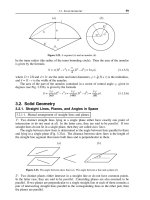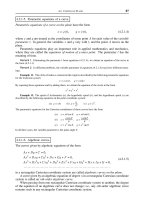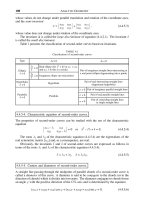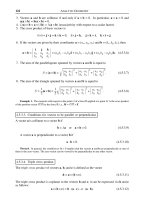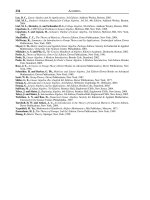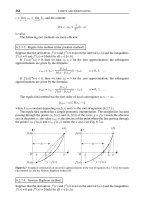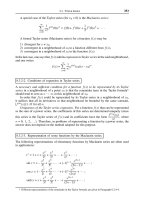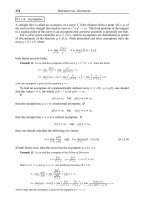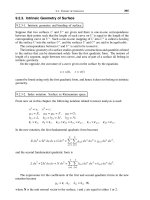Handbook of mathematics for engineers and scienteists part 89 ppt
Bạn đang xem bản rút gọn của tài liệu. Xem và tải ngay bản đầy đủ của tài liệu tại đây (411.92 KB, 7 trang )
584 FIRST-ORDER PARTIAL DIFFERENTIAL EQUATIONS
Example 2. Consider the terminal value problems for the more general Hamilton–Jacobi equation
∂w
∂x
+ H
∂w
∂y
= 0 (0 ≤ x ≤ L) (13.2.3.18)
with an arbitrary initial condition
w = ϕ(y)atx = L. (13.2.3.19)
The following two statements hold:
1
◦
. Let the Hamiltonian satisfy the Lipschitz condition
|H(q
2
)–H(q
1
)| ≤ β|q
2
– q
1
| for any q
1
, q
2
R, (13.2.3.20)
and let the function ϕ(y) be convex. Then the function
w(x, y)=sup
q R
qy +(L – x)H(q)–ϕ
∗
(q)
is the viscosity solution of problem (13.2.3.18), (13.2.3.19). The function ϕ
∗
is the conjugate of ϕ, i.e.,
ϕ
∗
(q)=sup
x R
qx – ϕ(x)
.
2
◦
. Let the Hamiltonian H be convex and satisfy the Lipschitz condition (13.2.3.20). Let the function ϕ(y)be
continuous. Then the function
w(x, y)=sup
t R
ϕ(y +(L – x)t)–(L – x)H
∗
(t)
is the viscosity solution of problem (13.2.3.18), (13.2.3.19). The function
H
∗
(t)=sup
q R
qt – H(q)
is the conjugate of the Hamiltonian.
References for Chapter 13
Bardi, M. and Dolcetta, I. C., Optimal Control and Viscosity Solutions of Hamilton–Jacobi–Bellman Equa-
tions,Birkh
¨
auser Verlag, Boston, 1998.
Barron,E.N.andJensen,R.,Generalized viscosity solutions for Hamilton–Jacobi equations with time-
measurable Hamiltonians, J. Different. Equations, Vol. 68, No. 1, pp. 10–21, 1987.
Courant, R. and Hilbert, D., Methods of Mathematical Physics, Vol. 2, Wiley-Interscience, New York, 1989.
Crandall, M. G., Evans, L. C., and Lions, P L., Some properties of viscosity solutions of Hamilton–Jacobi
equations, Trans. Amer. Math. Soc., Vol. 283, No. 2, pp. 487–502, 1984.
Gelfand, I. M., Some problems of the theory of quasi-linear equations, Uspekhi Matem. Nauk, Vol. 14, No. 2,
pp. 87–158, 1959 [Amer. Math. Soc. Translation, Series 2, pp. 295–381, 1963].
Hopf, E., Generalized solutions of nonlinear equations of first order, J. Math. Mech., Vol. 14, pp. 951–973,
1965.
Jeffery, A., Quasilinear Hyperbolic Systems and Waves, Pitman, London, 1976.
Kamke, E., Differentialgleichungen: L
¨
osungsmethoden und L
¨
osungen, II, Partielle Differentialgleichungen
Erster Ordnung f
¨
ur eine gesuchte Funktion, Akad. Verlagsgesellschaft Geest & Portig, Leipzig, 1965.
Kruzhkov, S. N., Generalized solutions of nonlinear first order equations with several variables [in Russian],
Mat. Sbornik, Vol. 70, pp. 394–415, 1966.
Lax, P. D., Hyperbolic systems of conservation laws and the mathematical theory of shock waves [reprint from
the classical paper of 1957], Society for Industrial & Applied Mathematics, Philadelphia, 1997.
Melikyan,A.A.,Generalized Characteristics of First Order PDEs: Applications in Optimal Control and
Differential Games,Birkh
¨
auser Verlag, Boston, 1998.
Oleinik, O. A., Discontinuous solutions of nonlinear differential equations, Uspekhi Matem. Nauk, Vol. 12,
No. 3, pp. 3–73, 1957 [Amer. Math. Soc. Translation, Series 2, Vol. 26, pp. 95–172, 1963].
Petrovskii, I. G., Lectures on the Theory of Ordinary Differential Equations [in Russian], Nauka Publishers,
Moscow, 1970.
Polyanin, A. D., Zaitsev, V. F., and Moussiaux, A., Handbook of First Order Partial Differential Equations,
Taylor & Francis, London, 2002.
Rhee, H., Aris, R., and Amundson, N. R., First Order Partial Differential Equations, Vols. 1 and 2, Prentice
Hall, Englewood Cliffs, New Jersey, 1986 and 1989.
Rozhdestvenskii, B. L. and Yanenko, N. N., Systems of Quasilinear Equations and Their Applications to Gas
Dynamics, American Mathematical Society, Providence, Rhode Island, 1983.
Smoller, J., Shock Waves and Reaction-Diffusion Equations, Springer-Verlag, New York, 1994.
Subbotin, A. I., Generalized Solutions of First Order PDEs: the Dynamical Optimization Perspective,
Birkh
¨
auser Verlag, Boston, 1995.
Whitham, G. B., Linear and Nonlinear Waves, Wiley, New York, 1974.
Chapter 14
Linear Partial Differential Equations
14.1. Classification of Second-Order Partial Differential
Equations
14.1.1. Equations with Two Independent Variables
14.1.1-1. Examples of equations encountered in applications.
Three basic types of partial differential equations are distinguished—parabolic, hyperbolic,
and elliptic. The solutions of the equations pertaining to each of the types have their own
characteristic qualitative differences.
The simplest example of a parabolic equation is the heat equation
∂w
∂t
–
∂
2
w
∂x
2
= 0,(14.1.1.1)
where the variables t and x play the role of time and the spatial coordinate, respectively. Note
that equation (14.1.1.1) contains only one highest derivative term. Frequently encountered
particular solutions of equation (14.1.1.1) can be found in Paragraph T8.1.1-1.
The simplest example of a hyperbolic equation is the wave equation
∂
2
w
∂t
2
–
∂
2
w
∂x
2
= 0,(14.1.1.2)
where the variables t and x play the role of time and the spatial coordinate, respectively.
Note that the highest derivative terms in equation (14.1.1.2) differ in sign.
The simplest example of an elliptic equation is the Laplace equation
∂
2
w
∂x
2
+
∂
2
w
∂y
2
= 0,(14.1.1.3)
where x and y play the role of the spatial coordinates. Note that the highest derivative
terms in equation (14.1.1.3) have like signs. Frequently encountered particular solutions of
equation (14.1.1.3) can be found in Paragraph T8.3.1-1.
Any linear partial differential equation of the second-order with two independent vari-
ables can be reduced, by appropriate manipulations, to a simpler equation that has one of
the three highest derivative combinations specified above in examples (14.1.1.1), (14.1.1.2),
and (14.1.1.3).
14.1.1-2. Types of equations. Characteristic equations.
Consider a second-order partial differential equation with two independent variables that
has the general form
a(x, y)
∂
2
w
∂x
2
+ 2b(x, y)
∂
2
w
∂x∂y
+ c(x, y)
∂
2
w
∂y
2
= F
x, y, w,
∂w
∂x
,
∂w
∂y
,(14.1.1.4)
585
586 LINEAR PARTIAL DIFFERENTIAL EQUATIONS
where a, b, c are some functions of x and y that have continuous derivatives up to the
second-order inclusive.*
Given a point (x, y), equation (14.1.1.4) is said to be
parabolic if b
2
– ac = 0,
hyperbolic if b
2
– ac > 0,
elliptic if b
2
– ac < 0
at this point.
In order to reduce equation (14.1.1.4) to a canonical form, one should first write out the
characteristic equation
a (dy)
2
– 2bdxdy+ c (dx)
2
= 0,
which splits into two equations
ady–
b +
√
b
2
– ac
dx = 0 (14.1.1.5)
and
ady–
b –
√
b
2
– ac
dx = 0,(14.1.1.6)
and then find their general integrals.
Remark. The characteristic equations (14.1.1.5)–(14.1.1.5) may be used if a 0.Ifa ≡ 0,thesimpler
equations
dx = 0,
2bdy– cdx= 0
should be used; the fi rst equation has the obvious general solution x = C.
14.1.1-3. Canonical form of parabolic equations (case b
2
– ac = 0).
In this case, equations (14.1.1.5) and (14.1.1.6) coincide and have a common general
integral,
ϕ(x, y)=C.
By passing from x, y to new independent variables ξ, η in accordance with the relations
ξ = ϕ(x, y), η = η(x, y),
where η = η(x, y) is any twice differentiable function that satisfies the condition of nonde-
generacy of the Jacobian
D(ξ,η)
D(x,y)
in the given domain, we reduce equation (14.1.1.4) to the
canonical form
∂
2
w
∂η
2
= F
1
ξ, η, w,
∂w
∂ξ
,
∂w
∂η
.(14.1.1.7)
As η, one can take η = x or η = y.
It is apparent that the transformed equation (14.1.1.7) has only one highest-derivative
term, just as the heat equation (14.1.1.1).
Remark. In the degenerate case where the function F
1
does not depend on the derivative ∂
ξ
w, equa-
tion (14.1.1.7) is an ordinary differential equation for the variable η,inwhichξ serves as a parameter.
* The right-hand side of equation (14.1.1.4) may be nonlinear. The classifi cation and the procedure of
reducing such equations to a canonical form are only determined by the left-hand side of the equation.
14.1. CLASSIFICATION OF SECOND-ORDER PARTIAL DIFFERENTIAL EQUATIONS 587
14.1.1-4. Canonical forms of hyperbolic equations (case b
2
– ac > 0).
The general integrals
ϕ(x, y)=C
1
, ψ(x, y)=C
2
of equations (14.1.1.5) and (14.1.1.6) are real and different. These integrals determine two
different families of real characteristics.
By passing from x, y to new independent variables ξ, η in accordance with the relations
ξ = ϕ(x, y), η = ψ(x, y),
we reduce equation (14.1.1.4) to
∂
2
w
∂ξ∂η
= F
2
ξ, η, w,
∂w
∂ξ
,
∂w
∂η
.
This is the so-called first canonical form of a hyperbolic equation.
The transformation
ξ = t + z, η = t – z
brings the above equation to another canonical form,
∂
2
w
∂t
2
–
∂
2
w
∂z
2
= F
3
t, z, w,
∂w
∂t
,
∂w
∂z
,
where F
3
= 4F
2
. Thisistheso-calledsecond canonical form of a hyperbolic equation.
Apart from notation, the left-hand side of the last equation coincides with that of the wave
equation (14.1.1.2).
In some cases, reduction of an equation to a canonical form allows finding its general
solution.
Example. The equation
kx
∂
2
w
∂x
2
+
∂
2
w
∂x∂y
= 0
is a special case of equation (14.1.1.4) with a = kx, b =
1
2
, c = 0,andF = 0. The characteristic equations
kx dy – dx = 0,
dy = 0
have the general integrals ky –ln|x| = C
1
and y = C
2
. Switching to the new independent variables
ξ = ky –ln|x|, η = y
reduces the original equation to the canonical form
∂
2
w
∂ξ∂η
= k
∂w
∂ξ
.
Integrating with respect to ξ yields the linear first-order equation
∂w
∂η
= kw + f(η)
where f(η) is an arbitrary function. Its general solution is expressed as
w = e
kη
g(ξ)+e
kη
e
–kη
f(η) dη,
where g(ξ) is an arbitrary function.
588 LINEAR PARTIAL DIFFERENTIAL EQUATIONS
14.1.1-5. Canonical form of elliptic equations (case b
2
– ac < 0).
In this case the general integrals of equations (14.1.1.5) and (14.1.1.6) are complex conju-
gate; these determine two families of complex characteristics.
Let the general integral of equation (14.1.1.5) have the form
ϕ(x, y)+iψ(x, y)=C, i
2
=–1,
where ϕ(x, y)andψ(x, y) are real-valued functions.
By passing from x, y to new independent variables ξ, η in accordance with the relations
ξ = ϕ(x, y), η = ψ(x, y),
we reduce equation (14.1.1.4) to the canonical form
∂
2
w
∂ξ
2
+
∂
2
w
∂η
2
= F
4
ξ, η, w,
∂w
∂ξ
,
∂w
∂η
.
Apart from notation, the left-hand side of the last equation coincides with that of the Laplace
equation (14.1.1.3).
14.1.1-6. Linear constant-coefficient partial differential equations.
1
◦
. When reduced to a canonical form, linear homogeneous constant-coefficient partial
differential equations
a
∂
2
w
∂x
2
+ 2b
∂
2
w
∂x∂y
+ c
∂
2
w
∂y
2
+ p
∂w
∂x
+ q
∂w
∂y
+ sw = 0 (14.1.1.8)
admit further simplifications. In general, the substitution
w(x, y)=exp(β
1
ξ + β
2
η)u(ξ, η)(14.1.1.9)
can be used. Here, ξ and η are new variables used to reduce equation (14.1.1.8) to a
canonical form (see Paragraphs 14.1.1-3 to 14.1.1-5); the coefficients β
1
and β
2
in (14.1.1.9)
are chosen so that there is only one first derivative remaining in a parabolic equation or
both first derivatives vanish in a hyperbolic or an elliptic equation. For final results, see
Table 14.1.
2
◦
. The coefficients k and k
1
in the reduced hyperbolic and elliptic equations (see the third,
fourth, and fifth rows in Table 14.1) are expressed as
k =
2bpq – aq
2
– cp
2
16a(b
2
– ac)
2
–
s
4a(b
2
– ac)
, k
1
=
s
4b
2
+
cp
2
– 2bpq
16b
4
.(14.1.1.10)
If the coefficients in equation (14.1.1.8) satisfy the relation
2bpq – aq
2
– cp
2
– 4s(b
2
– ac)=0,
then k = 0; in this case with a ≠ 0, the general solution of the corresponding hyperbolic
equation has the form
w(x, y)=exp(β
1
ξ + β
2
η)
f(ξ)+g(η)
, D = b
2
– ac > 0,
ξ = ay –
b +
√
D
x, η = ay –
b –
√
D
x,
β
1
=
aq – bp
4aD
+
p
4a
√
D
, β
2
=
aq – bp
4aD
–
p
4a
√
D
,
where f(ξ)andg(ξ) are arbitrary functions.
14.1. CLASSIFICATION OF SECOND-ORDER PARTIAL DIFFERENTIAL EQUATIONS 589
TABLE 14.1
Reduction of linear homogeneous constant-coefficient partial differential equations (14.1.1.8) using
transformation (14.1.1.9); the constants k and k
1
are given by formulas (14.1.1.10)
Type of equation,
conditions on coefficients
Vari ab les ξ and η in
transformation (14.1.1.9)
Coefficients β
1
and β
2
in
transformation (14.1.1.9)
Reduced
equation
Parabolic equation,
a = b = 0, c ≠ 0, p ≠ 0
ξ =–
c
p
x, η = y
β
1
=
4cs–q
2
4c
2
, β
2
=–
q
2c
u
ξ
–u
ηη
= 0
Parabolic equation, b
2
–ac = 0
(aq –bp ≠ 0, |a| +|b| ≠ 0)
ξ =
a(ay –bx)
bp – aq
, η = x
β
1
=
4as–p
2
4a
2
, β
2
=–
p
2a
u
ξ
–u
ηη
= 0
Hyperbolic equation,
a ≠ 0, D = b
2
–ac > 0
ξ = ay –
b+
√
D
x,
η = ay –
b–
√
D
x
β
1,2
=
aq –bp
4aD
p
4a
√
D
u
ξη
+ku = 0
Hyperbolic equation,
a = 0, b ≠ 0
ξ = x,
η = 2by – cx
β
1
=
cp –2bq
4b
2
, β
2
=–
p
4b
2
u
ξη
+k
1
u = 0
Elliptic equation,
D = b
2
–ac < 0
ξ = ay –bx,
η =
√
|D| x
β
1
=
aq –bp
2aD
, β
2
=–
p
2a
√
|D|
u
ξξ
+u
ηη
+4ku = 0
Ordinary differential equation,
b
2
–ac = 0, aq –bp = 0
ξ = ay –bx,
η = x
β
1
= β
2
= 0
aw
ηη
+pw
η
+sw = 0
3
◦
. In the degenerate case b
2
– ac = 0, aq – bp = 0 (where the original equation is reduced
to an ordinary differential equation; see the last row in Table 14.1), the general solution of
equation (14.1.1.8) is expressed as
w =exp
–
px
2a
f(ay – bx)exp
x
√
λ
2a
+ g(ay – bx)exp
–
x
√
λ
2a
if λ = p
2
– 4as > 0,
w =exp
–
px
2a
f(ay – bx)sin
x
√
|λ|
2a
+ g(ay – bx)cos
x
√
|λ|
2a
if λ = p
2
– 4as < 0,
w =exp
–
px
2a
f(ay – bx)+xg(ay – bx)
if 4as – p
2
= 0,
where f(z)andg(z) are arbitrary functions.
14.1.2. Equations with Many Independent Variables
Let us consider a second-order partial differential equation with n independent variables
x
1
, , x
n
that has the form
n
i,j=1
a
ij
(x)
∂
2
w
∂x
i
∂x
j
= F
x, w,
∂w
∂x
1
, ,
∂w
∂x
n
,(14.1.2.1)
where the a
ij
are some functions that have continuous derivatives with respect to all
variables to the second-order inclusive, and x = {x
1
, , x
n
}. [The right-hand side of equa-
tion (14.1.2.1) may be nonlinear. The left-hand side only is required for the classification
of this equation.]
At a point x = x
0
, the following quadratic form is assigned to equation (14.1.2.1):
Q =
n
i,j=1
a
ij
(x
0
)ξ
i
ξ
j
.(14.1.2.2)
590 LINEAR PARTIAL DIFFERENTIAL EQUATIONS
TABLE 14.2
Classification of equations with many independent variables
Type of equation (14.1.2.1) at a point x = x
0
Coefficients of the canonical form (14.1.2.4)
Parabolic (in the broad sense)
At least one coefficient of the c
i
is zero
Hyperbolic (in the broad sense) All c
i
are nonzero and some c
i
differ in sign
Elliptic All c
i
are nonzero and have like signs
By an appropriate linear nondegenerate transformation
ξ
i
=
n
k=1
β
ik
η
k
(i = 1, , n)(14.1.2.3)
the quadratic form (14.1.2.2) can be reduced to the canonical form
Q =
n
i=1
c
i
η
2
i
,(14.1.2.4)
where the coefficients c
i
assume the values 1,–1,and0. The number of negative and zero
coefficients in (14.1.2.4) does not depend on the way in which the quadratic form is reduced
to the canonical form.
Table 14.2 presents the basic criteria according to which the equations with many
independent variables are classified.
Suppose all coefficients of the highest derivatives in (14.1.2.1) are constant, a
ij
= const.
By introducing the new independent variables y
1
, , y
n
in accordance with the formulas
y
i
=
n
k=1
β
ik
x
k
,wheretheβ
ik
are the coefficients of the linear transformation (14.1.2.3), we
reduce equation (14.1.2.1) to the canonical form
n
i=1
c
i
∂
2
w
∂y
2
i
= F
1
y, w,
∂w
∂y
1
, ,
∂w
∂y
n
.(14.1.2.5)
Here, the coefficients c
i
are the same as in the quadratic form (14.1.2.4), and y={y
1
, , y
n
}.
Remark 1. Among the parabolic equations, it is conventional to distinguish the parabolic equations in
the narrow sense, i.e., the equations for which only one of the coefficients, c
k
, is zero, while the other c
i
is the
same, and in this case the right-hand side of equation (14.1.2.5) must contain the first-order partial derivative
with respect to y
k
.
Remark 2. In turn, the hyperbolic equations are divided into normal hyperbolic equations—for which
all c
i
but one have like signs—and ultrahyperbolic equations—for which there are two or more positive c
i
and
two or more negative c
i
.
Specific equations of parabolic, elliptic, and hyperbolic types will be discussed further
in Section 14.2.
14.2. Basic Problems of Mathematical Physics
14.2.1. Initial and Boundary Conditions. Cauchy Problem.
Boundary Value Problems
Every equation of mathematical physics governs infinitely many qualitatively similar phe-
nomena or processes. This follows from the fact that differential equations have infinitely
